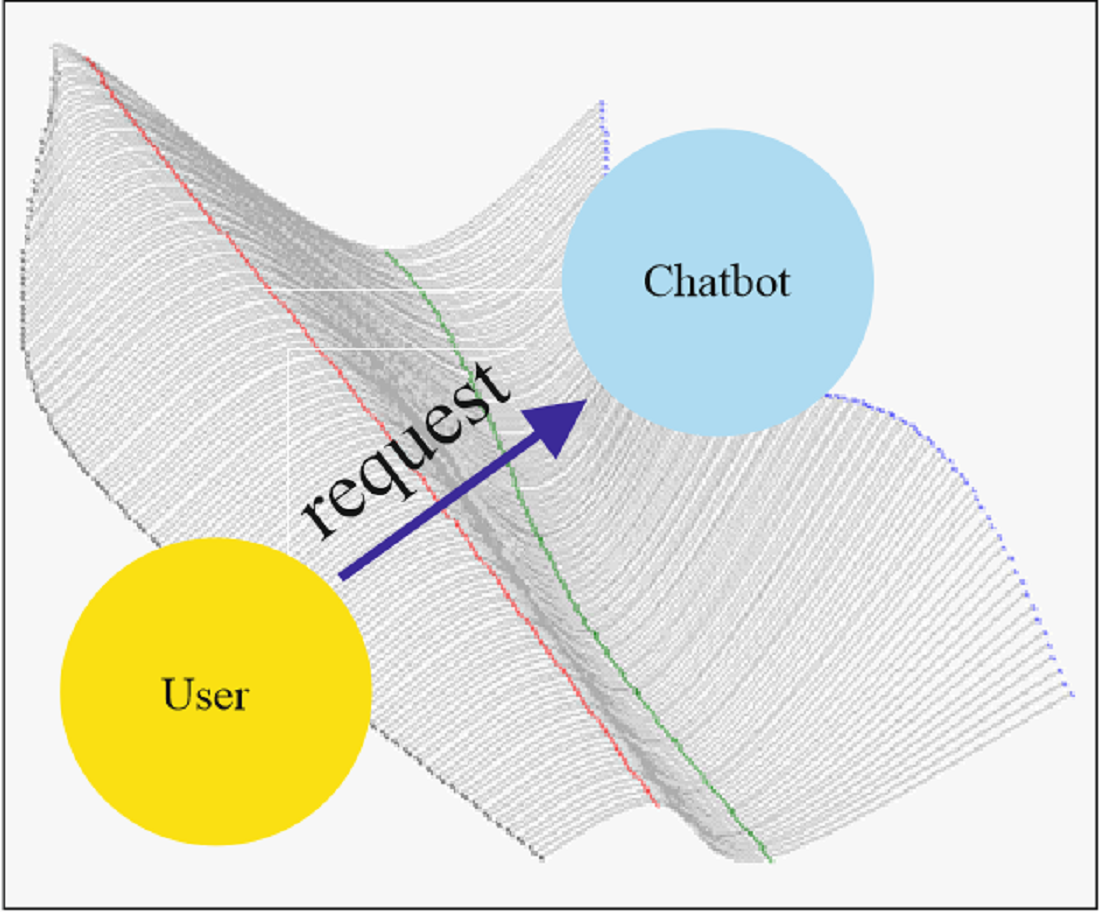Розробка моделі співставлення лінгвістичних конструкцій користувача з мовною моделлю чат-бота
DOI:
https://doi.org/10.15587/1729-4061.2024.304048Ключові слова:
породжувальний штучний інтелект, рекурентний алгоритм, формалізація запиту користувача, базова послідовністьАнотація
Об’єктом дослідження роботи виступають лінгвістичні конструкції користувача при побудові запиту до чат-бота з породжувальним штучним інтелектом. В роботі вирішувалася проблема вдосконалення алгоритмів комунікаційного посередництва чат-ботів через моделі співставлення лінгвістичних конструкцій користувачів. Іноді користувач навмисно чи через брак інформації формує неточний запит. Формалізовано це описується логічними операціями «І» та «І або Ні».
В результаті дослідження була побудована модель співставлення лінгвістичних конструкцій на вході з інформаційною моделлю відповіді на виході. В основу моделі був покладений підхід з рекурсійним створенням відповіді. Це дозволило визначати базові характеристики щодо об’єкту запиту і на цій основі формувати відповідь. Використання зазначеного підходу покращило точність формування відповіді від чат-бота. Також це дозволило розглянути лінгвістичну конструкцію користувача через її формалізацію. Використання алгебри логіки дозволило знайти типові помилки користувачів при діалогах з породжувальним штучним інтелектом.
Особливістю розробки є те, що порівняння моделей лінгвістичних конструкцій формування запиту проводитися через рекурентний алгоритм. У підсумку це дозволяє провести співставлення запиту таким чином, щоб зменшити величину абсолютної похибки первинних даних на 0,02 % та спростити процес математичних розрахунків. При цьому отримана інформація стає більш точною – кількість посилань збільшується від 2 до 6 джерел.
Запропоноване може бути використане у практичній діяльності для вдосконалення технологій розпізнавання природної мови користувачів у чат-ботах з породжувальним штучним інтелектом. На цій основі можлива розробка різноманітних додатків та сервісів для навчання і практичної діяльності
Посилання
- Gkinko, L., Elbanna, A. (2023). The appropriation of conversational AI in the workplace: A taxonomy of AI chatbot users. International Journal of Information Management, 69, 102568. https://doi.org/10.1016/j.ijinfomgt.2022.102568
- Hauptmann, C., Krenzer, A., Völkel, J., Puppe, F. (2024). Argumentation effect of a chatbot for ethical discussions about autonomous AI scenarios. Knowledge and Information Systems. https://doi.org/10.1007/s10115-024-02074-x
- Auffarth, B. (2020). Artificial intelligence with python cookbook: proven recipes for applying ai algorithms and deep learning techniques using tensorflow 2.x and pytorch 1.6. PACKT Publishing, 468.
- Working Draft, Standard for Programming Language C++. Available at: https://www.open-std.org/jtc1/sc22/wg21/docs/papers/2017/n4713.pdf
- Zuo, Z., Zeng, Z., Su, W., Huang, Q., Ke, Y., Liu, Z. et al. (2023). Specification transformation method for functional program generation based on partition-recursion refinement rule. Information Sciences, 633, 613–632. https://doi.org/10.1016/j.ins.2023.03.055
- Bian, W., Li, C., Hou, H., Liu, X. (2023). Iterative convolutional enhancing self-attention Hawkes process with time relative position encoding. International Journal of Machine Learning and Cybernetics, 14 (7), 2529–2544. https://doi.org/10.1007/s13042-023-01780-2
- Sannella, D., Fourman, M., Peng, H., Wadler, P. (2021). Introduction to Computation. In Undergraduate Topics in Computer Science. Springer International Publishing. https://doi.org/10.1007/978-3-030-76908-6
- Bossard, A. (2022). The SOF Programming Paradigm. International Journal of Software Innovation, 10 (1), 1–14. https://doi.org/10.4018/ijsi.309965
- Nirala, K. K., Singh, N. K., Purani, V. S. (2022). A survey on providing customer and public administration based services using AI: chatbot. Multimedia Tools and Applications, 81 (16), 22215–22246. https://doi.org/10.1007/s11042-021-11458-y
- Park, G., Chung, J., Lee, S. (2022). Effect of AI chatbot emotional disclosure on user satisfaction and reuse intention for mental health counseling: a serial mediation model. Current Psychology, 42 (32), 28663–28673. https://doi.org/10.1007/s12144-022-03932-z
- Niu, B., Mvondo, G. F. N. (2024). I Am ChatGPT, the ultimate AI Chatbot! Investigating the determinants of users’ loyalty and ethical usage concerns of ChatGPT. Journal of Retailing and Consumer Services, 76, 103562. https://doi.org/10.1016/j.jretconser.2023.103562
- Huang, R. S., Lu, K. J. Q., Meaney, C., Kemppainen, J., Punnett, A., Leung, F.-H. (2023). Assessment of Resident and AI Chatbot Performance on the University of Toronto Family Medicine Residency Progress Test: Comparative Study. JMIR Medical Education, 9, e50514. https://doi.org/10.2196/50514
- Xie, Y., Seth, I., Hunter‐Smith, D. J., Rozen, W. M., Seifman, M. A. (2023). Investigating the impact of innovative AI chatbot on post‐pandemic medical education and clinical assistance: a comprehensive analysis. ANZ Journal of Surgery, 94 (1-2), 68–77. https://doi.org/10.1111/ans.18666
- Kuckelman, I. J., Yi, P. H., Bui, M., Onuh, I., Anderson, J. A., Ross, A. B. (2024). Assessing AI-Powered Patient Education: A Case Study in Radiology. Academic Radiology, 31 (1), 338–342. https://doi.org/10.1016/j.acra.2023.08.020
- Dongbo, M., Miniaoui, S., Fen, L., Althubiti, S. A., Alsenani, T. R. (2023). Intelligent chatbot interaction system capable for sentimental analysis using hybrid machine learning algorithms. Information Processing & Management, 60 (5), 103440. https://doi.org/10.1016/j.ipm.2023.103440
- Noroozi, N., Mironchenko, A., Wirth, F. R. (2022). A relaxed small-gain theorem for discrete-time infinite networks. Automatica, 142, 110363. https://doi.org/10.1016/j.automatica.2022.110363

##submission.downloads##
Опубліковано
Як цитувати
Номер
Розділ
Ліцензія
Авторське право (c) 2024 Olha Kryazhych, Oleksandr Vasenko, Liudmyla Isak, Ihor Havrylov, Yevhen Gren

Ця робота ліцензується відповідно до Creative Commons Attribution 4.0 International License.
Закріплення та умови передачі авторських прав (ідентифікація авторства) здійснюється у Ліцензійному договорі. Зокрема, автори залишають за собою право на авторство свого рукопису та передають журналу право першої публікації цієї роботи на умовах ліцензії Creative Commons CC BY. При цьому вони мають право укладати самостійно додаткові угоди, що стосуються неексклюзивного поширення роботи у тому вигляді, в якому вона була опублікована цим журналом, але за умови збереження посилання на першу публікацію статті в цьому журналі.
Ліцензійний договір – це документ, в якому автор гарантує, що володіє усіма авторськими правами на твір (рукопис, статтю, тощо).
Автори, підписуючи Ліцензійний договір з ПП «ТЕХНОЛОГІЧНИЙ ЦЕНТР», мають усі права на подальше використання свого твору за умови посилання на наше видання, в якому твір опублікований. Відповідно до умов Ліцензійного договору, Видавець ПП «ТЕХНОЛОГІЧНИЙ ЦЕНТР» не забирає ваші авторські права та отримує від авторів дозвіл на використання та розповсюдження публікації через світові наукові ресурси (власні електронні ресурси, наукометричні бази даних, репозитарії, бібліотеки тощо).
За відсутності підписаного Ліцензійного договору або за відсутністю вказаних в цьому договорі ідентифікаторів, що дають змогу ідентифікувати особу автора, редакція не має права працювати з рукописом.
Важливо пам’ятати, що існує і інший тип угоди між авторами та видавцями – коли авторські права передаються від авторів до видавця. В такому разі автори втрачають права власності на свій твір та не можуть його використовувати в будь-який спосіб.










